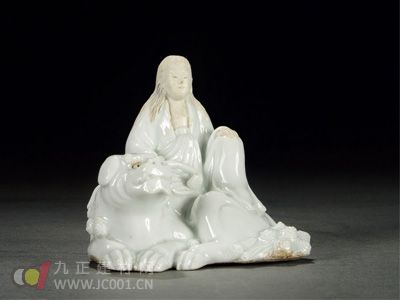How to Identify Green and White Porcelain: First, examine the glaze. The Qingbai porcelain from the Song Dynasty was mainly produced at the Hutian Kiln. Modern workshops often use this as a standard for imitation. They try to achieve a white glaze with a subtle blue tone, resembling jade, but often overdo it, resulting in an unnatural appearance. The genuine Qingbai porcelain from the Song Dynasty used a high-calcium glaze with up to 14% calcium oxide. Fired at around 1300°C, the glaze had a high degree of fluidity. As a result, areas like the edges, corners, and curved parts of the vessels had thicker glaze, appearing lake-blue with small, bubble-like formations. The surface was smooth and glossy. Most imitations use lime-soda glazes with lower calcium content, which don’t flow as much during firing. Their glaze is more uniform and lacks the natural variations seen in authentic pieces. Some imitations attempt to simulate thick glaze by applying it manually in specific areas, making the color deeper. However, these artificial glazes lack the delicate, frothy bubbles found in real porcelain. Instead, they look flat and blocky. Some imitations have overly bright surfaces that lack the soft luster of ancient "Baoguang." Others use acid etching to create a dull finish, but this often results in an unnatural, heavy texture that can be spotted upon closer inspection. Second, check the body (fetus) quality. Many sources describe the body of Song-era Qingbai porcelain as white and firm, with a high degree of vitrification. While this is true relative to the standards of its time, modern porcelain is just as refined and even more consistent in quality. The actual body of Song-era Qingbai porcelain from the Hutian Kiln was slightly brownish or light gray. This was due to the absence of the porcelain stone and kaolin mixture, which was developed later in the Yuan Dynasty. As a result, the body wasn’t as strong or fine as today’s porcelain. You can see visible pores when looking at the cross-section. Additionally, the clay used in the Song period was not as finely ground as modern materials. Many authentic pieces show small slag particles on the exposed areas, especially at the bottom. Modern imitations, however, tend to have smooth, white, and very dense bodies, making them easy to distinguish. Some workshops try to mimic the old look by mixing in colored soil or sand, altering the color and texture of the body. Others apply loess or black mud to the exposed areas to create a worn appearance. These tricks are usually easy to spot with some basic knowledge. Third, observe the foot. Authentic Song-era Qingbai porcelain typically used three methods for the base: the “Mangkou†(rim-covered), “stacked ring,†or “cake-burned†technique. Contemporary imitations often copy the first two, but since the base is exposed, it's easier to identify if you understand the characteristics of the original body. The third method involves burning the piece on a cake. Real cake marks are faint khaki or brownish yellow, with varying shades. Imitations, however, are often created after firing using artificial glazes, pigments, or other materials to simulate the mark. These fake marks are usually too dark, uniform, and lack the natural variation of real ones. Some imitations simply coat the bottom with yellow water or mud to mimic the effect. Be careful—some genuine pieces have unglazed bases with full glaze and cake marks, while others may have both cake and nail marks, which are not typical of authentic kiln practices and are clear signs of imitation. Fourth, study the shape. Due to the long history and numerous kilns producing green and white porcelain, there is a vast variety of forms. From daily-use items to ritual objects, the types are extensive. Understanding the basic shapes and their evolution across different periods is essential for accurate identification. Most modern imitations are based on official publications or preserved examples, making them relatively easy to spot. However, some models are so convincing that they can easily mislead even experienced collectors. It’s important to stay alert and keep learning about the nuances of each period. Classification By Spring Application Scenario Spring Application,Spring Manufacturer,Spring Solutions Dongguan Jiufukai Hardware Products Co., Ltd , https://www.jfkspring.com